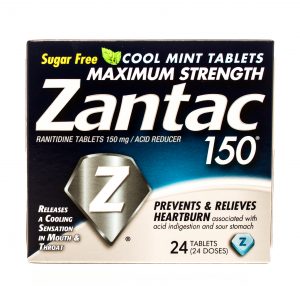 If you truly want to learn about a particular litigation involving a defective product (such as Zantac), the best place to start is the Master Complaint. This is the lengthy comprehensive document filed by the plaintiffs in a multi-district litigation involving a defective product. This does not mean the case is a class action. Most product liability cases are not class action lawsuits but are rather individual lawsuits gathered together in a “multi-district litigation or MDL.” These cases are transferred from across the country in one court, where one federal court judge will oversee the litigation until either (1) a global settlement is reached or (2) the cases are ready to be returned to the their home courts for trial.
If you truly want to learn about a particular litigation involving a defective product (such as Zantac), the best place to start is the Master Complaint. This is the lengthy comprehensive document filed by the plaintiffs in a multi-district litigation involving a defective product. This does not mean the case is a class action. Most product liability cases are not class action lawsuits but are rather individual lawsuits gathered together in a “multi-district litigation or MDL.” These cases are transferred from across the country in one court, where one federal court judge will oversee the litigation until either (1) a global settlement is reached or (2) the cases are ready to be returned to the their home courts for trial.
The multi-district litigation involving the drug Zantac is located in the Southern District of Florida (MDL No. 2924). On June 22, 2020 the plaintiffs filed their Master Personal Injury Complaint. It is a long and detailed document, and it is worth your time to read if you have taken Zantac over an extended period, and certainly if you have taken Zantac and later developed cancer.
 Many people, understandably, are not thrilled to read a 158-page legal document. So today and in the days to follow I am going to write up key bullet points from the Zantac Master Complaint. First, a few general guidelines: a complaint is the document a plaintiff files in a court to start a civil case. It can be a single page, alleging that the neighbor’s dog bit the plaintiff and caused injuries, or it can be hundreds of pages long, involving many defendants and many claims. The key thing to remember is that the complaint involves allegations, not proven facts. It may well be that every word of a complaint is true and that the plaintiffs provide compelling evidence for every allegation at trial. But at the start of a civil case the complaint should be understood as a series of allegations, which the defendants are allowed to deny and which they often deny. And that’s where the courts and juries come in: to figure out which side has proven its case.
Many people, understandably, are not thrilled to read a 158-page legal document. So today and in the days to follow I am going to write up key bullet points from the Zantac Master Complaint. First, a few general guidelines: a complaint is the document a plaintiff files in a court to start a civil case. It can be a single page, alleging that the neighbor’s dog bit the plaintiff and caused injuries, or it can be hundreds of pages long, involving many defendants and many claims. The key thing to remember is that the complaint involves allegations, not proven facts. It may well be that every word of a complaint is true and that the plaintiffs provide compelling evidence for every allegation at trial. But at the start of a civil case the complaint should be understood as a series of allegations, which the defendants are allowed to deny and which they often deny. And that’s where the courts and juries come in: to figure out which side has proven its case.
The Master Complaint in the Zantac MDL makes over one hundred pages of allegations against companies involved in the manufacture, sale, distribution, and repackaging of ranitidine, both with brand-name Zantac and its generic equivalents.
Let’s dive in. Before the Master Complaint can even get to the allegations connecting ranitidine to cancer-causing compounds, it must first set out the parties involved.
The Plaintiffs:
 The Plaintiffs in the Zantac MDL are people who took prescription or over-the-counter (OTC) Zantac or generic ranitidine over a period of time, later developed certain cancers, and then brought a claim for damages. For MDL No. 2924, these plaintiffs must be residents of the United States, and they can include not only the individuals who were diagnosed with cancer, but also the spouses, children, heirs, and estates of other cancer-stricken plaintiffs. The cancers involved include “bladder, brain, breast, colorectal, esophageal or throat, intestinal, kidney, liver, lung, ovarian, pancreatic, prostate, stomach, testicular, thyroid, and uterine.” Master Complaint, p. 5. Other cancers may well be involved in this litigation, and this list should not be taken as exhaustive. The bottom-line is this: if you took Zantac and later developed any cancer, you should have a competent attorney investigate your possible case.
The Plaintiffs in the Zantac MDL are people who took prescription or over-the-counter (OTC) Zantac or generic ranitidine over a period of time, later developed certain cancers, and then brought a claim for damages. For MDL No. 2924, these plaintiffs must be residents of the United States, and they can include not only the individuals who were diagnosed with cancer, but also the spouses, children, heirs, and estates of other cancer-stricken plaintiffs. The cancers involved include “bladder, brain, breast, colorectal, esophageal or throat, intestinal, kidney, liver, lung, ovarian, pancreatic, prostate, stomach, testicular, thyroid, and uterine.” Master Complaint, p. 5. Other cancers may well be involved in this litigation, and this list should not be taken as exhaustive. The bottom-line is this: if you took Zantac and later developed any cancer, you should have a competent attorney investigate your possible case.
The Defendants:
Brand-Name Manufacturers. These are the multi-national pharmaceutical companies that manufactured and sold brand-name Zantac for decades:
- Boehringer Ingelheim Pharmaceuticals, Inc.
- GlaxoSmithKline (GSK)
- Pfizer
- Sanofi-Aventis
Generic Manufacturers. These are the companies that manufactured, marketed and sold generic ranitidine. There are dozens of these companies, from Acic Pharmaceuticals to Zydus Pharmaceuticals (literally A to Z). I won’t list them all here, but you can access all of them in the Master Complaint if interested.
Distributor Defendants. These are the companies that purchase ranitidine products from manufacturers and then sell to Retailers. The following distributor defendants control 92% of the total volume of ranitidine distribution:
- AmerisourceBergen
- Cardinal Health, Inc.
- McKesson Corporation
Retailer Defendants. Retail Defendants are those companies with drugstores you can walk into, or online pharmacies from which you can purchase medications like Zantac. These companies may also repackage ranitidine and place their own individual labels. As you can imagine there are dozens of these companies. I won’t list them all here, but Retailer Defendants include Amazon, Costco, CVS, RiteAid, Walgreens, Walmart, and many smaller companies.
Repackager Defendants. These defendants include several defendants referenced above, but this class of defendants is simple enough: repackagers take a generic ranitidine product and place different labels on the medication and sell as their own product. For example, when you buy Costco or CVS brand ranitidine, you are buying from a repackager. Other Repackager Defendants include Denton Pharma, Golden State Medical Supply, and Precision Dose.
So these are the players in the Zantac litigation as identified in the Master Complaint. In Part 2, I will work to simplify the factual allegations involving Zantac and ranitidine, focusing on the key allegations connecting the medication to N-Nitrosodimethylamine (“NDMA”), which is a cancer-causing compound, and which, according to the Complaint, has caused hundreds of thousands of people to be afflicted with many types of cancer.
As always, if you took Zantac or a generic and have further questions, you can always call me to discuss further: 919.546.8788. Good luck.
 North Carolina Product Liability Lawyer Blog
North Carolina Product Liability Lawyer Blog

